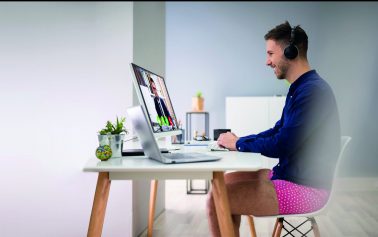The post-COVID workplace
 Now that vaccination programmes are underway and we’re contemplating a return to a more normal way of life, it’s time to start thinking about what the post-COVID workplace will look like. What lessons have we learned from the pandemic experience? How can we do things better? What do employees actually want, and what do they need from employers as we move into the future? Can we make our working practices more resilient so that if we face further pandemics in the future – which epidemiologists think is a significant risk – we’ll be able to cope more effectively?
Now that vaccination programmes are underway and we’re contemplating a return to a more normal way of life, it’s time to start thinking about what the post-COVID workplace will look like. What lessons have we learned from the pandemic experience? How can we do things better? What do employees actually want, and what do they need from employers as we move into the future? Can we make our working practices more resilient so that if we face further pandemics in the future – which epidemiologists think is a significant risk – we’ll be able to cope more effectively?
No going back
The stress caused by the pandemic has been immense, and many people feel a yearning for every aspect of life to go back to the way that it used to be. However, this is one option that we know is impractical. There are three main reasons for this.
Firstly, adjusting to the pandemic has shown us that there were a lot of things we were doing inefficiently. If you don’t make adjustments with this in mind, you can be sure that your competitors will, and then you’re going to find yourself struggling.
Secondly, many people who became infected by the virus have not gone back to the way they were. Cases of long COVID are running at about 10%. This means that skilled workers who still have a lot to give could be unable to return to work unless adjustments are made to help them work around their difficulties.
Thirdly, we’re going to be living with an increased threat from coronaviruses for a long time. COVID-19 has already produced several significant mutations, and most virologists think that we will need vaccinations annually to ensure immunity from developing strains. We’ll also need to be smarter about infection control in the workplace.
What we’ve learned about remote working
When we first made the leap to mass remote working, many business owners worried that productivity would fall. Overall though, home-based working has been a resounding success.
Research by Lenovo found that two-thirds of people around the world believed that they were more productive when working from home, and more than half of them expected to continue and even increase remote working after the pandemic. Rates of overtime increased, but because they were no longer commuting, employees were still able to achieve a better work-life balance.
However, it is important to recognise that while most employees would welcome flexible working, not everybody has been able to make the adjustment in the same way. More than half of parents found it difficult to juggle responsibilities when working from home, but this may be less of a problem when schools return to normal. People found it significantly easier to manage if they had a study, spare room or other separate space from which to work. Some struggled to stay motivated and missed having colleagues directly on hand to ask for help, but these problems seemed to decrease over time as individual solutions emerged.
What employees want
One US study found that a startling 98% of employees wanted to retain the option of working remotely, while another found that 72% would be willing to take a pay cut in order to do so. In the US and the UK, 80% of workers said that the experience has improved their quality of life, making them feel healthier and enhancing their family relationships. Hybrid working seems to be the preferred option. Research by HubbleHQ found that three quarters felt that their employers ought to maintain a physical office, and only 15% liked the idea of working from home all the time.
While some employees found self-discipline difficult, others flourished when able to work on a productivity-focused rather than time-focused basis. A downside for some is that the boundaries between work and home life have become blurred, making it harder for them to ‘switch off’ and relax or sleep. Others feel that they may be expected to be more ‘reachable’ out of office hours. This suggests that taking a more individual approach could help employers to get the best out of their staff.
If your employees continue to work from home, you will still be responsible for ensuring that they get proper training and know how to undertake work activities safely. Training in the safe use of display screen equipment (DSE) is particularly important.
If workers still use your premises, even just occasionally, you must ensure that they continue to receive fire awareness training. Further safety training (e.g. manual handling and food safety) must also continue to be delivered as mandated.
What this means for employers
Mercer’s global COVID-19 survey found that 90% of participating employers confirmed that productivity within their organisation had remained the same or had increased through remote working.
According to Forbes, statistics collected from leading research institutions worldwide, including Gallup, Harvard University, Global Workplace Analytics and Stanford University, suggest that not only is employee performance increased through remote working, but also that stronger engagement is reflected by 41% lower absenteeism. This data also shows that 54% of employees would select – or move – to a job that offered more flexibility.
In light of this information, employers’ attitudes are changing and organisations are looking at ways to introduce flexible or hybrid working to improve employee experience and ensure that they are competitive in attracting the best talent – while potentially reducing workplace overheads, enhancing productivity, and contributing to a more environmentally friendly society.
Working with technology
The shift to home working was difficult for many people because employers didn’t always step in to provide computer equipment or use software they found easy to engage with. Research by Robert Walters found that over half of UK employees wanted their employers to invest in better technology. The change made a big difference to the fortunes of technology companies and drove a wave of innovation, so there are now many more options to choose from, but employers and employees need to talk to each other to find mutually acceptable solutions.
Microsoft’s Human Factors Labs found that most people start to feel tired by remote meetings after 30 to 40 minutes and become stressed about two hours into a day that’s going to be full of such meetings. Individuals report difficulty in concentrating and say that they struggle with not being able to make eye contact through platforms such as Zoom. Of course, looking at any kind of screen for too long is bad for the eyes, so employers have a responsibility to make sure that their employees are using equipment appropriately and taking regular breaks.
When cyber-security specialists Centrify asked employees what they thought about the security implications of home working, 71% said that they thought they faced a greater risk of a security breach and 46% have already found that they were subject to more phishing attempts. A worrying 27% had not received any additional training on how to stay cyber-safe at home, suggesting that a substantial number of businesses have major security holes. Those businesses that intend to continue with home working should immediately think about how they might make it more secure.
Changing office needs
If business owners do choose to maintain physical offices, should those offices be the same as they were in the past? If you’re moving to a hybrid system of working, you could potentially move to smaller premises and bring in employees on different days instead of all at once. Of course, if you do this, you will need to update your fire safety procedures in order to keep careful track of who is there, when, so that you can be sure that everybody is accounted for in the event of a fire or similar emergency.
In order to keep employees safe from infection and reduce related anxiety, employers will need to review office cleaning practices and consider increased use of PPE. Ventilation systems will need to be looked at to see if they can be made safer. There will also need to be a new focus on employee wellness, ensuring that anybody who feels ill can take time off without worrying about being penalised for it. This will reduce the risk of them passing on infections to others.
The world of work is going to be very different post-pandemic, but if we learn our lessons well, we can make it safer, more secure, and a much more positive experience for all involved.

